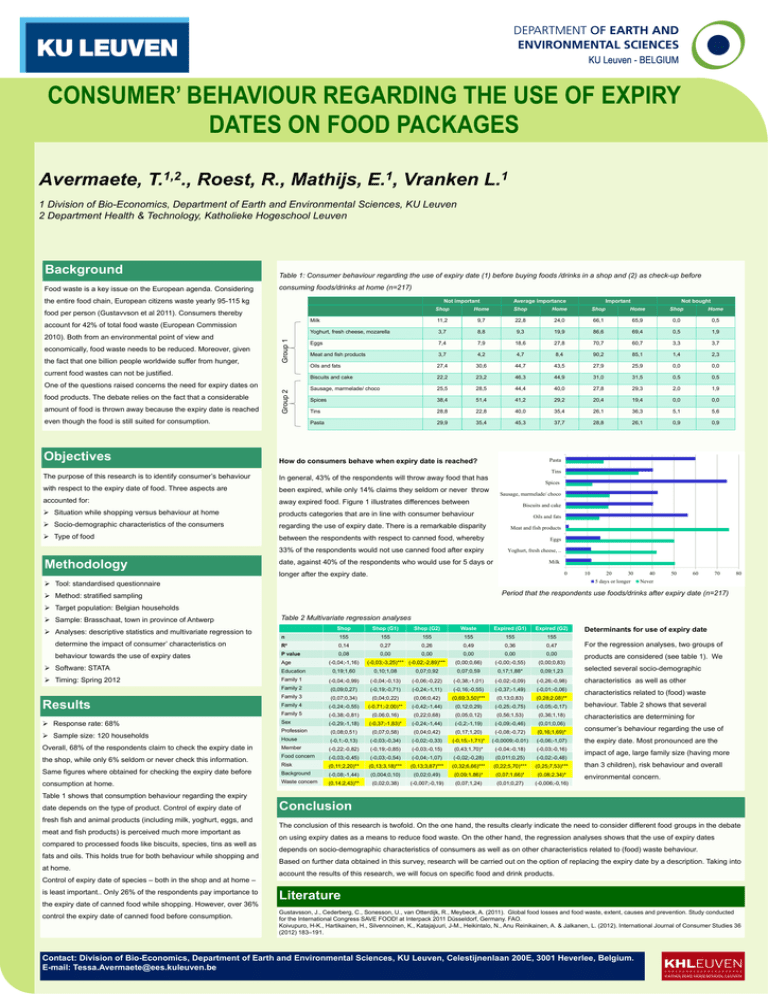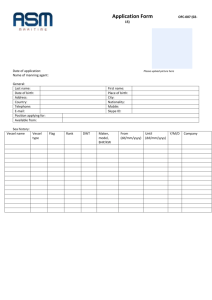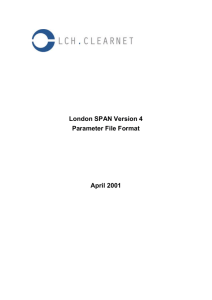
CONSUMER’ BEHAVIOUR REGARDING THE USE OF EXPIRY
DATES ON FOOD PACKAGES
Avermaete,
1,2
T. .,
Roest, R., Mathijs,
1
E. ,
Vranken
1
L.
1 Division of Bio-Economics, Department of Earth and Environmental Sciences, KU Leuven
2 Department Health & Technology, Katholieke Hogeschool Leuven
Background
Table 1: Consumer behaviour regarding the use of expiry date (1) before buying foods /drinks in a shop and (2) as check-up before
Food waste is a key issue on the European agenda. Considering
consuming foods/drinks at home (n=217)
the entire food chain, European citizens waste yearly 95-115 kg
Not important
economically, food waste needs to be reduced. Moreover, given
the fact that one billion people worldwide suffer from hunger,
Group 1
2010). Both from an environmental point of view and
current food wastes can not be justified.
food products. The debate relies on the fact that a considerable
amount of food is thrown away because the expiry date is reached
Group 2
One of the questions raised concerns the need for expiry dates on
even though the food is still suited for consumption.
Objectives
The purpose of this research is to identify consumer’s behaviour
with respect to the expiry date of food. Three aspects are
Not bought
Home
Shop
Home
Shop
Home
Shop
Home
Milk
11,2
9,7
22,8
24,0
66,1
65,9
0,0
0,5
Yoghurt, fresh cheese, mozarella
3,7
8,8
9,3
19,9
86,6
69,4
0,5
1,9
Eggs
7,4
7,9
18,6
27,8
70,7
60,7
3,3
3,7
Meat and fish products
3,7
4,2
4,7
8,4
90,2
85,1
1,4
2,3
Oils and fats
27,4
30,6
44,7
43,5
27,9
25,9
0,0
0,0
Biscuits and cake
22,2
23,2
46,3
44,9
31,0
31,5
0,5
0,5
Sausage, marmelade/ choco
25,5
28,5
44,4
40,0
27,8
29,3
2,0
1,9
Spices
38,4
51,4
41,2
29,2
20,4
19,4
0,0
0,0
Tins
28,8
22,8
40,0
35,4
26,1
36,3
5,1
5,6
Pasta
29,9
35,4
45,3
37,7
28,8
26,1
0,9
0,9
Pasta
How do consumers behave when expiry date is reached?
Tins
In general, 43% of the respondents will throw away food that has
Spices
been expired, while only 14% claims they seldom or never throw
Sausage, marmelade/ choco
accounted for:
away expired food. Figure 1 illustrates differences between
Situation while shopping versus behaviour at home
products categories that are in line with consumer behaviour
Socio-demographic characteristics of the consumers
regarding the use of expiry date. There is a remarkable disparity
Type of food
between the respondents with respect to canned food, whereby
Eggs
33% of the respondents would not use canned food after expiry
Yoghurt, fresh cheese, ..
Methodology
Important
Shop
food per person (Gustavvson et al 2011). Consumers thereby
account for 42% of total food waste (European Commission
Average importance
Biscuits and cake
Oils and fats
Meat and fish products
date, against 40% of the respondents who would use for 5 days or
Milk
longer after the expiry date.
0
10
20
30
5 days or longer
Tool: standardised questionnaire
40
50
60
70
80
Never
Period that the respondents use foods/drinks after expiry date (n=217)
Method: stratified sampling
Target population: Belgian households
Sample: Brasschaat, town in province of Antwerp
Table 2 Multivariate regression analyses
Shop
Shop (G1)
Shop (G2)
Waste
Expired (G1)
Expired (G2)
n
155
155
155
155
155
155
determine the impact of consumer’ characteristics on
R²
0,14
0,27
0,26
0,49
0,36
0,47
For the regression analyses, two groups of
behaviour towards the use of expiry dates
P value
0,08
0,00
0,00
0,00
0,00
0,00
products are considered (see table 1). We
(0,00;0,66)
(-0,00;-0,55)
(0,00;0,83)
Analyses: descriptive statistics and multivariate regression to
Software: STATA
Age
(-0,03;-3,25)*** (-0,02;-2,89)***
selected several socio-demographic
0,19;1,60
0,10;1,08
0,07;0,92
0,07;0,59
0,17;1,88*
0,09;1,23
Family 1
(-0,04;-0,99)
(-0,04;-0,13)
(-0,06;-0,22)
(-0,38;-1,01)
(-0,02;-0,09)
(-0,26;-0,98)
characteristics as well as other
Family 2
(0,09;0,27)
(-0,19;-0,71)
(-0,24;-1,11)
(-0,16;-0,55)
(-0,37;-1,49)
(-0,01;-0,06)
Family 3
(0,07;0,34)
(0,04;0,22)
(0,06;0,42)
(0,69;3,50)***
(0,13;0,83)
(0,28;2,08)**
characteristics related to (food) waste
Family 4
(-0,24;-0,55)
(-0,71;-2,00)**
(-0,42;-1,44)
(0,12;0,29)
(-0,25;-0,75)
(-0,05;-0,17)
Family 5
(-0,38;-0,81)
(0,06;0,16)
(0,22;0,68)
(0,05;0,12)
(0,56;1,53)
(0,36;1,18)
Sex
(-0,29;-1,18)
(-0,37;-1,83)*
(-0,24;-1,44)
(-0,2;-1,19)
(-0,09;-0,46)
(0,01;0,06)
Profession
(0,08;0,51)
(0,07;0,58)
(0,04;0,42)
(0,17;1,20)
(-0,08;-0,72)
(0,16;1,69)*
consumer’s behaviour regarding the use of
House
(-0,1;-0,13)
(-0,03;-0,34)
(-0,02;-0,33)
(-0,15;-1,71)*
(-0,0009;-0,01)
(-0,06;-1,07)
the expiry date. Most pronounced are the
Member
(-0,22;-0,82)
(-0,19;-0,85)
(-0,03;-0,15)
(0,43;1,70)*
(-0,04;-0,18)
(-0,03;-0,16)
Food concern
(-0,03;-0,45)
(-0,03;-0,54)
(-0,04;-1,07)
(-0,02;-0,28)
(0,011;0,25)
(-0,02;-0,48)
Risk
(0,11;2,20)**
(0,13;3,18)***
(0,13;3,87)***
(0,32;6,66)***
(0,22;5,70)***
(0,25;7,53)***
Same figures where obtained for checking the expiry date before
Background
(-0,08;-1,44)
(0,004;0,10)
(0,02;0,49)
(0,09;1,86)*
(0,07;1,66)*
(0,08;2,34)*
consumption at home.
Waste concern
(0,14;2,43)**
(0,02;0,38)
(-0,007;-0,19)
(0,07;1,24)
(0,01;0,27)
(-0,006;-0,16)
Timing: Spring 2012
Results
Response rate: 68%
Sample size: 120 households
Overall, 68% of the respondents claim to check the expiry date in
the shop, while only 6% seldom or never check this information.
Education
(-0,04;-1,16)
Determinants for use of expiry date
behaviour. Table 2 shows that several
characteristics are determining for
impact of age, large family size (having more
than 3 children), risk behaviour and overall
environmental concern.
Table 1 shows that consumption behaviour regarding the expiry
date depends on the type of product. Control of expiry date of
fresh fish and animal products (including milk, yoghurt, eggs, and
meat and fish products) is perceived much more important as
compared to processed foods like biscuits, species, tins as well as
fats and oils. This holds true for both behaviour while shopping and
at home.
Control of expiry date of species – both in the shop and at home –
is least important.. Only 26% of the respondents pay importance to
the expiry date of canned food while shopping. However, over 36%
control the expiry date of canned food before consumption.
Conclusion
The conclusion of this research is twofold. On the one hand, the results clearly indicate the need to consider different food groups in the debate
on using expiry dates as a means to reduce food waste. On the other hand, the regression analyses shows that the use of expiry dates
depends on socio-demographic characteristics of consumers as well as on other characteristics related to (food) waste behaviour.
Based on further data obtained in this survey, research will be carried out on the option of replacing the expiry date by a description. Taking into
account the results of this research, we will focus on specific food and drink products.
Literature
Gustavsson, J., Cederberg, C., Sonesson, U., van Otterdijk, R., Meybeck, A. (2011). Global food losses and food waste, extent, causes and prevention. Study conducted
for the International Congress SAVE FOOD! at Interpack 2011 Düsseldorf, Germany. FAO.
Koivupuro, H-K., Hartikainen, H., Silvennoinen, K., Katajajuuri, J-M., Heikintalo, N., Anu Reinikainen, A. & Jalkanen, L. (2012). International Journal of Consumer Studies 36
(2012) 183–191.
Contact: Division of Bio-Economics, Department of Earth and Environmental Sciences, KU Leuven, Celestijnenlaan 200E, 3001 Heverlee, Belgium.
E-mail: Tessa.Avermaete@ees.kuleuven.be











